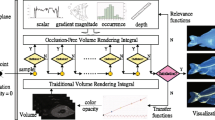Abstract
Feature enhancement is important for the interpretation of complex structures and the detection of local details in volume visualization. We present a simple and effective method, volumetric unsharp masking, to enhance local contrast of features. In general, unsharp masking is an operation that adds the scaled high-frequency part of the signal to itself. The signal in this paper is the radiance at each sample point in the ray-casting based volume rendering, and the radiance depends on both transfer functions and lighting. Our volumetric unsharp masking modulates the radiance by adding back the scaled difference between the radiance and the smoothed radiance. This local color modulation does not change the shape of features due to the same opacity, but it does enhance local contrast of structures in a unified manner. We implemented volumetric unsharp masking at interactive frame rates based on current GPU features, and performed experiments on various volume data sets to validate this local contrast enhancement. The results showed that volumetric unsharp masking reveals more local details and improves depth perception.
Similar content being viewed by others
References
Kindlmann, G.: Transfer function in direct volume rendering: Design, interface, interaction. ACM SIGGRAPH 2008 Course Notes (2002)
Viola, I., Kanitsar, A., Gröller, M.E.: Importance-driven feature enhancement in volume visualization. IEEE Trans. Vis. Comput. Graph. 11(4), 408–418 (2005)
Bruckner, S., Grimm, S., Kanitsar, A., Gröller, M.E.: Illustrative context-preserving volume rendering. In: Proceedings of EuroVis 2005, pp. 69–76 (2005)
Rusinkiewicz, S., Burns, M., DeCarlo, D.: Exaggerated shading for depicting shape and detail. ACM Trans. Graph. 25(3), 1199–1205 (2006) (SIGGRAPH 2006)
Ritschel, T., Smith, K., Ihrke, M., Grosch, T., Myszkowski, K., Seidel, H.-P.: 3D unsharp masking for scene coherent enhancement. ACM Trans. Graph. 27(3), 1–8 (2008) (SIGGRAPH 2008)
Max, N.: Optical models for direct volume rendering. IEEE Trans. Vis. Comput. Graph. 1(2), 99–108 (1995)
Behrens, U., Ratering, R.: Adding shadows to a texture-based volume renderer. In: Proceedings of IEEE symposium on Volume Visualization 1998, pp. 39–46 (1998)
Kniss, J., Premoze, S., Hansen, C., Shirley, P., McPherson, A.: A model for volume lighting and modeling. IEEE Trans. Vis. Comput. Graph. 9(2), 150–162 (2003)
Tarini, M., Cignoni, P., Montani, C.: Ambient occlusion and edge cueing to enhance real time molecular visualization. IEEE Trans. Vis. Comput. Graph. 12(6), 1237–1244 (2006) (Visualization 2006)
Ropinski, T., Meyer-Spradow, J., Diepenbrock, S., Mensmann, J., Hinrichs, K.: Interactive volume rendering with dynamic ambient occlusion and color bleeding. Comput. Graph. Forum 27(2), 567–576 (2008) (Eurographics 2008)
Levoy, M.: Display of surfaces from volume data. IEEE Comput. Graph. Appl. 8(3), 29–37 (1988)
Rheingans, P., Ebert, D.S.: Volume illustration: Non-photorealistic rendering of volume models. IEEE Trans. Vis. Comput. Graph. 7(3), 253–264 (2001)
Kindlmann, G., Whitaker, R., Tasdizen, T., Möller, T.: Curvature-based transfer functions for direct volume rendering: Methods and applications. In: Proceedings of IEEE Visualization 2003, pp. 513–520 (2003)
Svakhine, N.A., Ebert, D.S.: Interactive volume illustration and feature halos. In: Proceedings of the Pacific Conference on Computer Graphics and Applications 2003, pp. 347–354 (2003)
Bruckner, S., Gröller, E.: Enhancing depth-perception with flexible volumetric halos. IEEE Trans. Vis. Comput. Graph. 13(6), 1344–1351 (2007) (Visualization 2007)
Marchesin, S., Dischler, J.-M., Mongener, C.: Feature enhancement using locally adaptive volume rendering. In: Proceedings of IEEE/Eurographics International Symposium on Volume Graphics 2007, pp. 41–48 (2007)
Stewart, A.J.: Vicinity shading for enhanced perception of volumetric data. In: Proceedings of IEEE Visualization 2003, pp. 355–362 (2003)
Cignoni, P., Scopigno, R., Tarini, M.: A simple normal enhancement technique for interactive non-photorealistic renderings. Comput. Graph. 29(1), 125–133 (2005)
Luft, T., Colditz, C., Deussen, O.: Image enhancement by unsharp masking the depth buffer. ACM Trans. Graph. 25(3), 1206–1213 (2006) (SIGGRAPH 2006)
Badamchizadeh, M.A., Aghagolzadeh, A.: Comparative study of unsharp masking methods for image enhancement. In: Proceedings of International Conference on Image and Graphics 2004, pp. 27–30 (2004)
Kindlmann, G., Durkin, J.: Semi-automatic generation of transfer functions for direct volume rendering. In: Proceedings of IEEE symposium on Volume Visualization 1998, pp. 79–86 (1998)
Engel, K., Hadwiger, M., Kniss, J., Rezk-Salama, C., Weiskopf, D.: Real-time Volume Graphics. AK-Peters, Wellesley (2006)
Wittenbrink, C.M., Malzbender, T., Goss, M.E.: Opacity-weighted color interpolation for volume sampling. In: Proceedings of IEEE Symposium on Volume Visualization 1998, pp. 135–142 (1998)
Engel, K., Kraus, M., Ertl, T.: High-quality pre-integrated volume rendering using hardware-accelerated pixel shading. In: Proceedings of Graphics Hardware 2001, pp. 9–16 (2001)
Author information
Authors and Affiliations
Corresponding author
Rights and permissions
About this article
Cite this article
Tao, Y., Lin, H., Bao, H. et al. Feature enhancement by volumetric unsharp masking. Vis Comput 25, 581–588 (2009). https://doi.org/10.1007/s00371-009-0328-2
Published:
Issue Date:
DOI: https://doi.org/10.1007/s00371-009-0328-2




